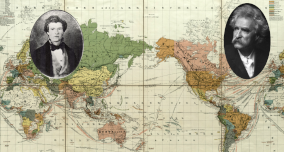Alton was developed as a river town in 1818 by Rufus Easton, who named it after his son. Easton ran a passenger ferry service across the Mississippi River to the Missouri shore. Alton is located amid the confluence of three significant navigable rivers: the Illinois, the Mississippi, and the Missouri. Alton grew into a river trading town with an industrial character. The city rises steeply from the waterfront, where massive concrete grain silos and railroad tracks were constructed in the 19th and 20th centuries to aid in shipping the area's grains and produce. Brick commercial buildings are located throughout downtown. Once the site of several brick factories, Alton has an unusually high number of streets still paved in brick. The lower levels of Alton are subject to floods, many of which have inundated the historic downtown area. The flood levels of different dates are marked on the large grain silos, part of the Ardent Mills, near the Argosy Casino at the waterfront. The flood of 1993 is considered the worst in the last 100 years.
https://en.wikipedia.org/wiki/Alton,_Illinois
ALTON – HER RAILROADS AND HER DESTINY
Source: Alton Telegraph, May 30, 1851
The fact is doubtless apparent to all who have taken the trouble to come and see, that for some two or three years past, Alton has been gradually rising from the position of “masterly inactivity,” which was her most prominent characteristic for several years succeeding the “back set” she received in 1836 and 1837 (time period when Rev. Elijah Lovejoy was murdered).
One of the first manifestations of improvement in our affairs was a successful effort, about two years since, to resuscitate the charter for a railroad from Alton to Springfield – the capital of the State. The road being some 75 miles in length, a great effort, on the part of our enterprising citizens, was requisite in order to obtain a sufficiently large subscription to the capital stock of the company to enable it to complete its organization. This, however, was finally accomplished by the aid of a subscription of $100,000 on the part of the city, in her corporate capacity, together with a handsome subscription in New York. Little more than one year since, the company was duly organized, and as soon as the arrangements could be made, a large force was employed upon the work, and has been almost constantly engaged ever since, with a very favorable prospect of the entire completion of the road before another year passes.
Another favorite work with our citizens is the Terre Haute and Alton Railroad, for which a liberal charter was obtained at the last session of the General Assembly. It will open up one of the richest and most productive belts of country to be found in all the length and breadth of the land. This road is viewed with great favor at the East, and requires only a united and vigorous effort on the part of its friends upon the line to insure its early completion.
Another road, of perhaps not inferior importance to the trade and business of our city, is the Alton, Mt. Carmel, and New Albany Railroad, running from Alton, via Mt. Carmel, on the Wabash, to New Albany, Indiana, on the Ohio River, immediately opposite Louisville. We cannot but regard this as one of the most important of all contemplated improvements. The charter for this road is of the most liberal character, and we hope the day is not far distant when active operations will be commenced upon it.
Last but not least, it is also proposed to build a railroad to connect Alton with Jacksonville, Morgan County, some 75 miles distant. The line of this road passes through the rich and productive counties of Jersey, Greene, and Morgan. We shall rejoice to see the friends of this important project actively engaged in placing its claims before the public.
Thus, it will be seen that Alton is to be the terminus of four magnificent lines of railway – justly entitling her to the cognomen of the “Railroad City.”
